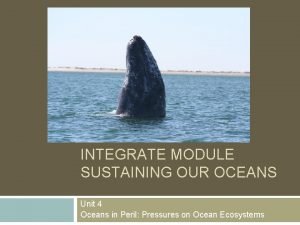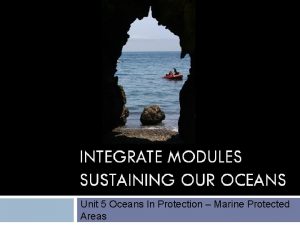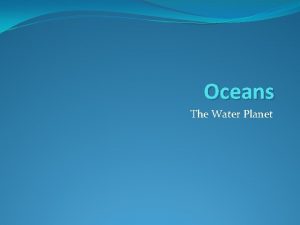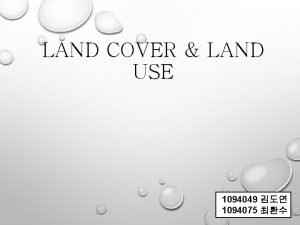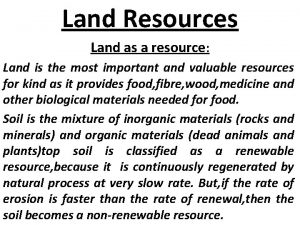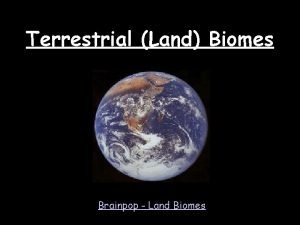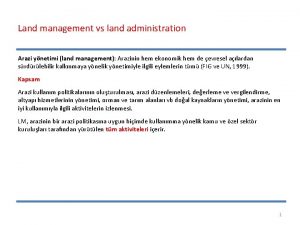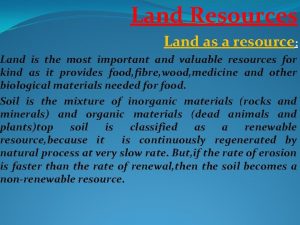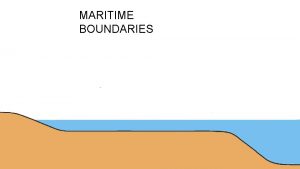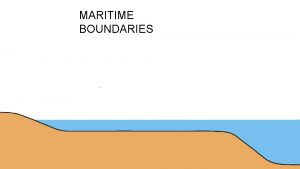Oceans Unit 3 Introduction The land oceans play












































- Slides: 44

Oceans Unit 3

Introduction • The land oceans play a major role for life on • Regulate temperatures, shape weather & climate patterns, cycle elements through the biosphere • Life on Earth originated in the oceans

Introduction • Understanding of the oceans have advanced greatly, but we still know very little about them https: //www. facebook. com/search/top/? q=h ow%20 deep%20 the%20 ocean%20 is

Ocean Structure & Composition • Different layers with different properties • Pressure increases with depth • More water on top pressing down • Pressure doubles every 10 meters down

Ocean Structure & Composition • Epipelagic=sunlight zone 1 st 200 meters below surface • Warm • Mixed by winds & waves • Only 2% of all ocean water •

Ocean Structure & Composition • @ 200 meters, Continental Shelf slopes sharply down • Mesopelagic=twilight zone • Temp fall to less than 5 degrees Celsius at 1, 000 meters below • • Thermocline=inhibits vertical mixing of water with different densities 18% of ocean water

Ocean Structure & Composition • Bathypelagic=midnight zone Below 1, 000 meters • Uniformly cold (4 degrees Celsius) • No sunlight • Pressure @ bottom of zone=5, 880 lb/in 2 •

Ocean Structure & Composition • Abyssopelagic=abyssal zone • Below 4, 000 meters to bottom • Little life exists here • Abyssal & midnight zones contain 80% of all ocean water

Ocean Structure & Composition • Deep ocean trenches occur where 2 ocean plates collide & one subducts below the other • Deepest trench is Marianas Trench near the Philipines (10, 000 meters deep) Highly specialized life can survive down here • Fish, shrimps, sea cucumbers, microbes •


Ocean Structure & Composition • Movements of plates generates earthquakes & tsunamis 2011 earthquake off the coast of japan was 9. 0 • 40. 5 m (133 ft) tsunami that traveled 10 km (6 mi) inland • Killed almost 16, 000 people, 6, 000 injuries, 2, 500 missing people, 230, 000 people without a home • • Many ocean trenches are along the Fire” “Ring of


Ocean Currents • Mixing is vital for the oceans Exchanges heat between surface/deep waters • Redistribute heat from low to high latitudes • Carry nutrients from deep to surface waters • Shape coastal climates •

Ocean Currents • Forces that cause ocean mixing Winds cause waves & surface currents • Deep ocean water is mixed due to differences in density • • • Salty & cold is denser than fresh and warm Along coastlines, warm surface water is blown away and deep cold water rises • upwelling

Ocean Currents • Upwelling surface brings nutrient rich water to the • Circular currents, gyres, occur at 25 -30 degrees latitudes. Counter-clockwise in northern • Clockwise in southern •

Ocean Currents • Ocean currents redistribute heat from high to low latitudes by moving warm water from the equator towards the poles. • As currents flow, they warm or cool the atmosphere • Upwelling will cause the atmosphere to cool


Ocean Currents • Ocean waters are warmest in the tropics and coldest at the poles • Angle of the sun’s rays • Oceans respond to temp changes slower than the atmosphere Water has high specific heat capacity • It takes more energy to increase temp •


Thermohaline Circulation • Global conveyor belt • Current rivers has a flow equal to 100 Amazon


Thermohaline Circulation • Driven by buoyancy differences due to temperature & salinity differences • Higher temps & salinity @ equator Direct sunlight @ equator • More evaporation @ equator leaves salt behind in water •


Thermohaline Circulation • The • ice melting at the poles lowers salinity Human driven climate change is increasing polar ice melting • If the conveyor belt slows, temperatures fall • If it increases, temperatures rise


Ocean Circulation and Climate Cycles • Monsoons arise when land & water heat up at sharply different rates • Hot air masses over land in the summer create low-pressure zones, bringing in moist ocean air • When the moist air is lifted by mountains, it condenses

Ocean Circulation and Climate Cycles • In the winter, land cools quicker than water • Warm air over water rises & draws winds from the continents producing clear weather over land • Southwestern US= Summer Monsoons from July-September

Ocean Circulation and Climate Cycles • Hurricanes occur from June-November in Atlantic & May-November in Pacific • Typical season has 11 named storms, 6 becoming hurricanes, 2 being major

Ocean Circulation and Climate Cycles • El Nino Southern Oscillation= every 3 -7 years • Normally Pacific • When a large gyre sits over southern it is strong enough, winds blowing are strong enough to pile warm water in the western pacific

Ocean Circulation and Climate Cycles • The movement of warm water causes an upwelling of cold nutrient rich water • • In Supports fisheries near coast of South America an El Nino year, everything flips into reverse

Ocean Circulation and Climate Cycles • The reversal of weak equatorial winds and warm water to South and Central America and California causes warm moist air to rise • North & South American coasts get heavy rains and landslides • Indonesia and Asia get droughts

Ocean Circulation and Climate Cycles • La Nina= unusually intensive reverse phase • Produces very wet weather in Asia and dryer than normal conditions in U. S. A • Full La Nina/ El Nino cycle lasts 5 years

Biological Activity in the Upper Ocean • Most organisms in the oceans are nourished directly or indirectly by plankton • Oceans account for nearly half to the world’s energy output • Nearly all of it is in the thin upper layer of the oceans

Biological Activity in the Upper Ocean • Phytoplankton, foundation of marine food chains, are microscopic • 2 types are the two most abundant organisms on Earth • 500, 000 cells per m. L of sea water

Biological Activity in the Upper Ocean • Producers water • in oceans work best in clear Phytoplankton can work as deep as 110 meters • Turbid coastal waters=only 20 meters deep • Pollution & dredging reduce biological productivity

Biological Activity in the Upper Ocean • If waters are mixed, phytoplankton can be dent down and not be as productive • If nutrients (C, N, P, Si, Fe) run out for phytoplankton, productivity lessens • Grazers also effect the productivity

Biological Activity in the Upper Ocean • If there is optimal light, temp, nutrients, and low numbers of grazers a bloom occurs • Blooms can color the oceans red, brow, or yellow-green • Blooms can deplete oxygen levels when the plankton die & decompose

Biological Activity in the Upper Ocean • Lack of oxygen can be dangerous to other sea life • Some blooms produce neurotoxins that are dangerous to humans and fish

Biological Activity in the Upper Ocean • Blooms can be triggered by runoff from fertilizers or chemicals or storms mixing oceans and bringing up nutrients • Usually occur in spring with rising temps and longer days • Most blooms are beneficial to ocean life

Biological Activity in the Upper Ocean • Climate cycles have a major impact on productivity in oceans • During El Nino, fewer plankton growth reduces food for anchovies and sardines, reducing food for tuna, sea lions and birds

The “Biological Pump” • Deep waters must have nutrients for plankton in the upper ocean • Nutrients are carried down in a rain of particles called marine snow • Fecal pellets, shells of dead plankton, and other dead/dying microorganisms

The “Biological Pump” • Most are too light to sink, but when they stick together they sink • It can take days/weeks to get to the ocean floor • Bottom-dwellers consume the “snow” • Other bits are oxidized and recycled into usable nutrients • The rest is buried in sediments, forming oil and gas deposits

The “Biological Pump” • The biological pump is also important to the global carbon cycle • Plankton take up carbon from the atmosphere and cycle it down through the “snow” to the bottom of the ocean • Without the biological pump, the concentrations of CO 2 would be much higher

 An area of land largely enclosed by higher land
An area of land largely enclosed by higher land What are landforms
What are landforms I've got a friend we like to play we play together
I've got a friend we like to play we play together Louise made the chocolate cake active or passive
Louise made the chocolate cake active or passive Play by play
Play by play Gozago
Gozago Unit 6 review questions
Unit 6 review questions Hình ảnh bộ gõ cơ thể búng tay
Hình ảnh bộ gõ cơ thể búng tay Bổ thể
Bổ thể Tỉ lệ cơ thể trẻ em
Tỉ lệ cơ thể trẻ em Chó sói
Chó sói Chụp tư thế worms-breton
Chụp tư thế worms-breton Alleluia hat len nguoi oi
Alleluia hat len nguoi oi Các môn thể thao bắt đầu bằng tiếng chạy
Các môn thể thao bắt đầu bằng tiếng chạy Thế nào là hệ số cao nhất
Thế nào là hệ số cao nhất Các châu lục và đại dương trên thế giới
Các châu lục và đại dương trên thế giới Công thức tiính động năng
Công thức tiính động năng Trời xanh đây là của chúng ta thể thơ
Trời xanh đây là của chúng ta thể thơ Mật thư anh em như thể tay chân
Mật thư anh em như thể tay chân Phép trừ bù
Phép trừ bù Phản ứng thế ankan
Phản ứng thế ankan Các châu lục và đại dương trên thế giới
Các châu lục và đại dương trên thế giới Thể thơ truyền thống
Thể thơ truyền thống Quá trình desamine hóa có thể tạo ra
Quá trình desamine hóa có thể tạo ra Một số thể thơ truyền thống
Một số thể thơ truyền thống Cái miệng bé xinh thế chỉ nói điều hay thôi
Cái miệng bé xinh thế chỉ nói điều hay thôi Vẽ hình chiếu vuông góc của vật thể sau
Vẽ hình chiếu vuông góc của vật thể sau Thế nào là sự mỏi cơ
Thế nào là sự mỏi cơ đặc điểm cơ thể của người tối cổ
đặc điểm cơ thể của người tối cổ V cc
V cc Vẽ hình chiếu đứng bằng cạnh của vật thể
Vẽ hình chiếu đứng bằng cạnh của vật thể Phối cảnh
Phối cảnh Thẻ vin
Thẻ vin đại từ thay thế
đại từ thay thế điện thế nghỉ
điện thế nghỉ Tư thế ngồi viết
Tư thế ngồi viết Diễn thế sinh thái là
Diễn thế sinh thái là Dot
Dot Thế nào là số nguyên tố
Thế nào là số nguyên tố Tư thế ngồi viết
Tư thế ngồi viết Lời thề hippocrates
Lời thề hippocrates Thiếu nhi thế giới liên hoan
Thiếu nhi thế giới liên hoan ưu thế lai là gì
ưu thế lai là gì Hổ sinh sản vào mùa nào
Hổ sinh sản vào mùa nào




















































